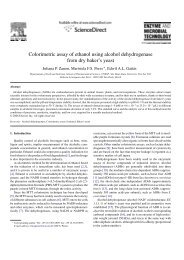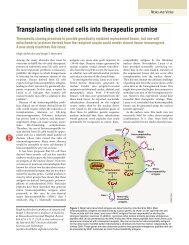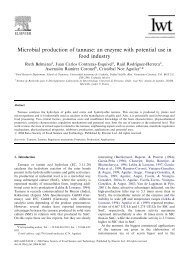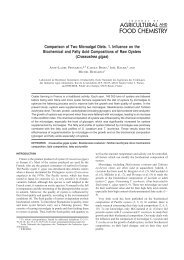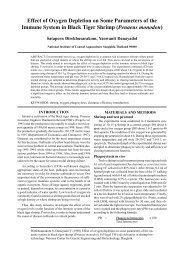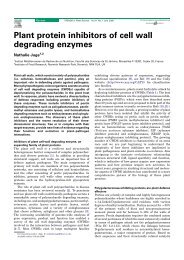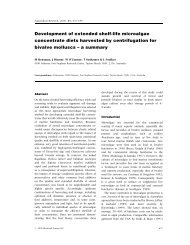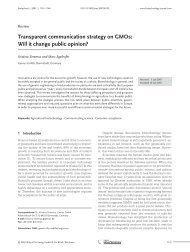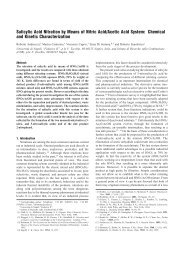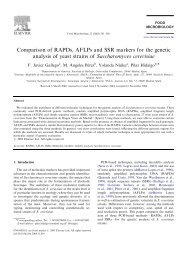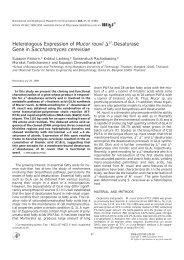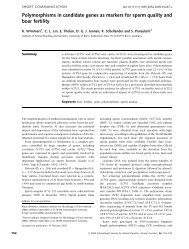Enzymatic microreactors in chemical analysis and kinetic studies
Enzymatic microreactors in chemical analysis and kinetic studies
Enzymatic microreactors in chemical analysis and kinetic studies
Create successful ePaper yourself
Turn your PDF publications into a flip-book with our unique Google optimized e-Paper software.
Table 2 (cont<strong>in</strong>ued)<br />
Enzyme Medium Application Refs.<br />
Horseradish peroxidase, Microbeads Measurement of enzyme k<strong>in</strong>etics Seong et al., 2003<br />
h-galactosidase<br />
(fluorescence imag<strong>in</strong>g)<br />
Lipase Glass beads, alg<strong>in</strong>ate gel<br />
Hydrolysis of triacet<strong>in</strong>,<br />
Pijanowska et al., 2001<br />
beads, nitrocellulose sheets tributyr<strong>in</strong> <strong>and</strong> triole<strong>in</strong><br />
Lipase SiO2-coated microcapillary Hydrolysis of umbelliferone acetate Nakamura et al., 2004<br />
Lipases, proteases,<br />
glucose oxidase,<br />
horseradish peroxidase<br />
Sol–gel arrays Screen<strong>in</strong>g of prote<strong>in</strong>s (enzymes) Park <strong>and</strong> Clark, 2002<br />
Peroxidase, glucose oxidase Silicon wafer Cont<strong>in</strong>uous glucose measurements Laurell <strong>and</strong> Rosengren, 1994<br />
PikC hydroxylase Ni-NTA agarose beads Rapid hydroxylation of macrolides Sr<strong>in</strong>ivasan et al., 2004<br />
Protease Silica monolith Transesterification (glycidol, n-butyrate) Kawakami et al., 2005<br />
Trehalase Am<strong>in</strong>opropyl glass particles Quantification of trehalose Bach<strong>in</strong>ski et al., 1997<br />
Urease Polydimethylsiloxane High urea conversion <strong>in</strong> cont<strong>in</strong>uous flow Jones et al., 2004<br />
B-Fructosidase Porous silicon Determ<strong>in</strong>ation of sucrose Lendl et al., 1997<br />
offers a great advantage by shorten<strong>in</strong>g the <strong>analysis</strong> time.<br />
In batch reactions, completion of enzyme-catalysed<br />
transesterification may take days for some supported<br />
lipases (Kamal et al., 2002).<br />
On account of reproducible distribution of the products<br />
formed along the axes of the microreactor, the<br />
enzymatic process can be visualized by fluorescence<br />
microscopy <strong>in</strong> order to acquire data on the concentration<br />
patterns <strong>in</strong>side the device. Such an approach was presented<br />
by Seong et al. (2003), <strong>and</strong> fluorescence images<br />
of the reaction zone together with scaled numerical<br />
results from the cross-sections of <strong>in</strong>put <strong>and</strong> output<br />
streams are shown <strong>in</strong> Fig. 4. The method provided<br />
high sensitivity for product detection <strong>and</strong> short response<br />
time, <strong>and</strong> k<strong>in</strong>etic graphs of the reaction catalyzed by the<br />
enzyme (horseradish peroxidase) were obta<strong>in</strong>ed. The<br />
Lilly–Hornby model was used to characterize the k<strong>in</strong>et-<br />
ics of biocatalysis <strong>in</strong> the packed microcolumn, <strong>and</strong><br />
results were compared with those for k<strong>in</strong>etics of the<br />
enzyme <strong>in</strong> homogeneous solution. The Michaelis constants<br />
were found to be similar to those obta<strong>in</strong>ed from<br />
the L<strong>in</strong>eweaver–Burke model for the homogeneous catalysis.<br />
In comparison with st<strong>and</strong>ard assays, the amount<br />
of enzyme used was very small: Seong et al. (2003)<br />
estimated that 200 pmol (3 10 9 molecules of enzyme)<br />
were required for the <strong>analysis</strong>. The current trend <strong>in</strong><br />
bio<strong>chemical</strong> <strong>analysis</strong> is to decrease the amount of biocatalyst<br />
used. Recently, Moore et al. (2004) presented an<br />
assay for 500 lipase molecules, capable of application to<br />
s<strong>in</strong>gle cells. Rondelez et al. (2005) described an assay<br />
for monitor<strong>in</strong>g reaction catalyzed by a s<strong>in</strong>gle molecule<br />
of h-galactosidase <strong>and</strong> horseradish peroxidase.<br />
The k<strong>in</strong>etics model described by Lilly et al. (1966) is<br />
appropriate for systems with cont<strong>in</strong>uous flow of the<br />
Fig. 3. Schematic for cont<strong>in</strong>uous-flow reaction <strong>and</strong> monitor<strong>in</strong>g of hydrolysis of esters us<strong>in</strong>g microreactor packed with lipase immobilized onto either<br />
nitrocellulose sheets or glass beads coated with kerat<strong>in</strong>. Repr<strong>in</strong>ted from Pijanowska et al. (2001) with permission from Elsevier.




